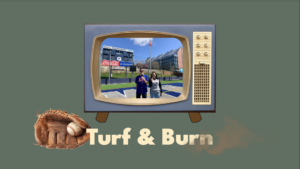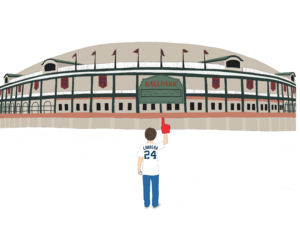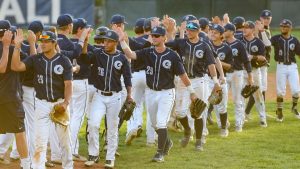In 1917, American Marines landed in the eastern province of Oriente in Cuba. The troops were invited to train there by then- Cuban president Mario García Menocal, a conservative politician who feared the growing levels of discontent among leftist rebels in his country. American troops would stay on the island for five years, in what is known as the Sugar Intervention, based on their goal to protect the interests of American owned sugar plantations on the island.
American troops proved to be very effective at the task they were given; 1918 was a record year for sugar production on the island. American forces stayed on the island until 1922, when the only presence left was found in the naval base at Guantanamo Bay. This would be an end to a 24- year stretch which saw three different US military interventions on the island.
The period of American military interventions in Cuba allowed for the rise of another form of contact between the two nations: baseball games. The game of baseball had been played on the island since the 1860s, when Cuban students studying in the United States brought it back. It quickly became popular, and it spread as a way to counter the Spanish colonial influence on Cuban life. In an era when Cubans were expected to attend bullfights, an ancient sport as ingrained in Spanish culture as any other sport to any country in the world, to play baseball was a sign of Cuban nationalism.
In 1899, the All Cubans, a team made up of professionals from the Cuban League began their tour of the United States. In their second trip in the early 1900s, the diverse All Cubans had different rosters for playing in both the Major Leagues and the Negro Leagues. Cuban baseball had integrated long before Americans determined what “All men are created equal” really means.
The most famous of these games happened in 1908, in the middle of America’s Second Occupation of Cuba. The Cincinnati Reds played a series of games against the Cuban All Stars. Cuban pitcher José Méndez was absolutely dominant, pitching 25 consecutive scoreless innings. Méndez would continue his dominance streak against American clubs, pitching in games against the Detroit Tigers, Philadelphia Phillies, and Brooklyn Dodgers. Méndez eventually had a very successful career in the American Negro Leagues, playing for the Los Angeles White Sox and the Kansas City Monarchs, among others. He is a member of the inaugural class of the Cuban Baseball hall of fame and was enshrined in Cooperstown in 2006.
At the time, the games played by Méndez and countless others were important to the cultural relations of the two nations. In an era of violent clashes with the American military in Cuba, a shared passion for baseball allowed for a sense of normalcy between the United States and its island neighbor to the south.
***
On Sunday, March 20, 2016, almost a century after those 1,000 troops landed on the shores of Eastern Cuba, Air Force One landed in Havana. President Barack Obama, First Lady Michelle, and countless other figures of American government began the first visit to Cuba by a sitting US President since Calvin Coolidge went to the island in 1928.
57 years after the Cuban revolution ushered in the Communist regime that holds power today, America’s relations with the island nation finally seem to be opening up slightly. President Obama has made it easier for Americans to visit the island, removed the nation from the US’s list of state sponsors of terror, and re- established embassies in both countries.
Obama’s visit is marked by a tone of optimism and hope. After a 50- year relationship that almost led to nuclear world war, the image of an American president being met at the Revolutionary Palace is one that can only lead to thoughts of a better future for both countries. The tone of partnership and communication was perhaps never as strong as when President Obama said, “The embargo’s going to end.”
While the visit is full of many different political statements, speeches, and meetings, there is another aspect of Obama’s time in Cuba. True to the diplomatic history of these two nations, the United States and Cuba once again met on the baseball diamond, ready to face off in the game that has for so long defined both of these countries.
On Tuesday, March 22, 2016, the Tampa Bay Rays played the Cuban national team, winning 4-1 in Havana’s Estadio Latinoamericano. It was the first time since 1999 that an MLB team played in Cuba, and President Obama sat alongside Cuban president Raúl Castro in front row seats. The image of these two leaders, whose nations have for so long been enemies, sitting next to each other watching the game will certainly be one of the most famous that comes out of President Obama’s visit.
Although the two nations are only separated by 90 miles at their closest points, 50 years of rhetoric espoused by both sides would have one believe that the two nations could not be more different. To a certain extent, this is true. Although recent changes have seen a liberalization of Cuba’s markets, it is still a mostly planned economy, in contrast to America’s market- based system. The Cubans view the relationship as one between a small nation focused on advancing the working class and their giant, imperialist neighbors. To Americans, it as an authoritarian dictatorship and a neighbor ready to advance the benefits of democracy and human rights. In a way, both sides are right.
None of those differences mattered on the field during Tuesday’s game. Regardless of which uniform a player wore, where he called home, or the ideology of the president in the stands, for 9 innings everything was equal. Home plate was still 60 feet 6 inches from the pitcher’s mound. There were still 3 outs per inning. It was just a baseball game.
***
Tuesday’s game was not the first time in history where a sports game transcended the usual meaning of athletic competition. In the early 1970s, there were multiple instances of “Ping Pong Diplomacy,” in which the American table tennis team visited China to combat against the Chinese team. This was one of the first examples of Sino- American contact during Mao’s Cultural Revolution. It is telling that American president Richard Nixon’s visit to China did not come until after these matches; between the US and China, sports came first, politics second.
Perhaps the most famous of these events was 1980’s “Miracle on Ice”. On February 22, 1980, the US Men’s Olympic national hockey team, made up of college and amateur players, beat the Soviet Union team, a team that had won 6 of the last 7 Gold Medals in the sport. That the game took place in 1980 is very telling of the political atmosphere that existed when it was played. After the USSR invaded Afghanistan in 1979, the period of Détente was officially over, and any apparent “warming” of relations had ended. When the two teams stepped out on the ice that February night, hostilities between their two nations were the worst they had been in decades.
Unlike the table tennis matches with China, the 1980 hockey game did little to make relations between the two nations any better. Summer of 1980 saw the United States team boycotting the Olympic Games in Moscow and the election of Ronald Reagan in November showed the US public had very little interest making amends with the Soviet Union. An American victory on the ice simply reinforced the idea that an American victory in the political sphere was the only possible outcome of the Cold War.
When American table tennis players entered China in 1971, there was a feeling of unease; the US and China were still, after all, at the end of a long period without any diplomatic contact. The Olympic hockey game between the USSR and the US was no matchup of two countries trying to move on from a bitter past; those who watched viewed it as nothing less than war on ice.
Tuesday’s game was different. There was neither an air of cold resentment nor of waning trepidation. Instead, it felt as if the two nations were trying to move forward from their collective past and look forward to a hopefully better future. It would be naïve to think that a baseball game could somehow undo 50 years of wrongs by both sides or could somehow remove entrenched ideologies that both sides hold. However, if any progress is to be made, it will only be done when both Americans and Cubans can see the humanity in those that live across the sliver of the Caribbean that separates the two nations. For 9 innings in Estadio Latinoamericano, players from both nations showed that the game was the same. They may as well have shown that the people are too.





